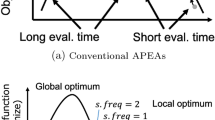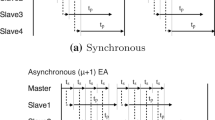Abstract
This paper attempts a new scheme of a semi-asynchronous parallel evolutionary algorithm (PEA), named time-limitation asynchronous PEA (TLAPEA). TLAPEA takes a balance between the search capability and the computational efficiency of PEA by synchronizing the solution evaluations within a particular waiting time before generating solutions. To reduce the idling time to wait for the slower evaluation of solutions, TLAPEA waits for a while for other solutions after the evaluation of a solution completes. The waiting time is decided from the average evaluation time of solutions and a new asynchrony parameter. This paper conducts an experiment to compare the proposed method with the full synchronous and asynchronous parallel evolutionary algorithm on multi-objective optimization problems. The experiment uses a state-of-the-art indicator-based multi-objective evolutionary algorithm, \(I_{\mathrm {SDE}}+\). Our experiment examines several variances of evaluation time on a parallel computing simulation. The experimental result reveals that TLAPEA with shorter time limitation obtains a high quality of solutions quicker than the synchronous and asynchronous ones regardless of the variance of the evaluation time.
This work was supported by Japan Society for the Promotion of Science Grant-in-Aid for Young Scientists Grant Number JP19K20362.
Access this chapter
Tax calculation will be finalised at checkout
Purchases are for personal use only
Similar content being viewed by others
References
Chang, J.F., Chu, S.C., Roddick, J.F., Pan, J.S.: A parallel particle swarm optimization algorithm with communication strategies. J. Inf. Sci. Eng. 21(4), 809–818 (2005)
Cheng, R., He, C., Jin, Y., Yao, X.: Model-based evolutionary algorithms: a short survey. Complex Intell. Syst. 4(4), 283–292 (2018). https://doi.org/10.1007/s40747-018-0080-1
Chipperfield, A., Fleming, P.: Parallel Genetic Algorithms, pp. 1118–1143. McGraw-Hill, New York (1996)
Deb, K., Agrawal, R.B.: Simulated binary crossover for continuous search space. Complex Syst. 9, 115–148 (1995). citeseer.ist.psu.edu/deb95simulated.html
Deb, K., Goyal, M.: A combined genetic adaptive search (GeneAS) for engineering design. Comput. Sci. Inf. 26, 30–45 (1996)
Durillo, J.J., Zhang, Q., Nebro, A.J., Alba, E.: Distribution of computational effort in parallel MOEA/D. In: Coello, C.A.C. (ed.) LION 2011. LNCS, vol. 6683, pp. 488–502. Springer, Heidelberg (2011). https://doi.org/10.1007/978-3-642-25566-3_38
Goldberg, D.E.: Genetic Algorithms in Search, Optimization and Machine Learning, 1st edn. Addison-Wesley Longman Publishing Co., Inc., Boston (1989)
Harada, T., Takadama, K.: Asynchronous evaluation based genetic programming: comparison of asynchronous and synchronous evaluation and its analysis. In: Krawiec, K., Moraglio, A., Hu, T., Etaner-Uyar, A.Ş., Hu, B. (eds.) EuroGP 2013. LNCS, vol. 7831, pp. 241–252. Springer, Heidelberg (2013). https://doi.org/10.1007/978-3-642-37207-0_21
Harada, T., Takadama, K.: Performance comparison of parallel asynchronous multi-objective evolutionary algorithm with different asynchrony. In: 2017 IEEE Congress on Evolutionary Computation (CEC), pp. 1215–1222, June 2017. https://doi.org/10.1109/CEC.2017.7969444
Harada, T., Takadama, K.: Analysis of semi-asynchronous multi-objective evolutionary algorithm with different asynchronies. Soft Comput. 24(4), 2917–2939 (2020). https://doi.org/10.1007/s00500-019-04071-7
Huband, S., Barone, L., While, L., Hingston, P.: A scalable multi-objective test problem toolkit. In: Coello Coello, C.A., Hernández Aguirre, A., Zitzler, E. (eds.) EMO 2005. LNCS, vol. 3410, pp. 280–295. Springer, Heidelberg (2005). https://doi.org/10.1007/978-3-540-31880-4_20
Jin, Y.: Surrogate-assisted evolutionary computation: recent advances and future challenges. Swarm Evol. Comput. 1(2), 61–70 (2011). https://doi.org/10.1016/j.swevo.2011.05.001, http://www.sciencedirect.com/science/article/pii/S2210650211000198
Koza, J.: Genetic Programming On the Programming of Computers by Means of Natural Selection. MIT Press, Cambridge (1992)
Kruskal, W.H., Wallis, W.A.: Use of ranks in one-criterion variance analysis. J. Am. Stat. Assoc. 47(260), 583–621 (1952). https://doi.org/10.2307/2280779
Mann, H.B., Whitney, D.R.: On a test of whether one of two random variables is stochastically larger than the other. Ann. Math. Stat. 18(1), 50–60 (1947). https://doi.org/10.1214/aoms/1177730491
Nebro, A.J., Durillo, J.J., Vergne, M.: Redesigning the jMetal multi-objective optimization framework. In: Proceedings of the Companion Publication of the 2015 Annual Conference on Genetic and Evolutionary Computation, pp. 1093–1100. GECCO Companion 2015. ACM, New York (2015). https://doi.org/10.1145/2739482.2768462, https://doi.acm.org/10.1145/2739482.2768462
Pamulapati, T., Mallipeddi, R., Suganthan, P.N.: \(I_{\rm SDE}\) +—an indicator for multi and many-objective optimization. IEEE Trans. Evol. Comput. 23(2), 346–352 (2019). https://doi.org/10.1109/TEVC.2018.2848921
Scott, E.O., De Jong, K.A.: Evaluation-time bias in asynchronous evolutionary algorithms. In: Proceedings of the Companion Publication of the 2015 Annual Conference on Genetic and Evolutionary Computation, pp. 1209–1212. GECCO Companion 2015. ACM, New York (2015). https://doi.org/10.1145/2739482.2768482, https://doi.acm.org/10.1145/2739482.2768482
Scott, E.O., De Jong, K.A.: Understanding simple asynchronous evolutionary algorithms. In: Proceedings of the 2015 ACM Conference on Foundations of Genetic Algorithms XIII, pp. 85–98. FOGA 2015. ACM, New York (2015). https://doi.org/10.1145/2725494.2725509, https://doi.acm.org/10.1145/2725494.2725509
Tasoulis, D.K., Pavlidis, N.G., Plagianakos, V.P., Vrahatis, M.N.: Parallel differential evolution. In: Proceedings of the 2004 Congress on Evolutionary Computation (IEEE Cat. No. 04TH8753), vol. 2, pp. 2023–2029, June 2004. https://doi.org/10.1109/CEC.2004.1331145
Zitzler, E., Thiele, L.: Multiobjective optimization using evolutionary algorithms—a comparative case study. In: Eiben, A.E., Bäck, T., Schoenauer, M., Schwefel, H.-P. (eds.) PPSN 1998. LNCS, vol. 1498, pp. 292–301. Springer, Heidelberg (1998). https://doi.org/10.1007/BFb0056872
Zăvoianu, A.C., Lughofer, E., Koppelstätter, W., Weidenholzer, G., Amrhein, W., Klement, E.P.: Performance comparison of generational and steady-state asynchronous multi-objective evolutionary algorithms for computationally-intensive problems. Knowl. Based Syst. 87(C), 47–60 (2015). https://doi.org/10.1016/j.knosys.2015.05.029
Author information
Authors and Affiliations
Corresponding author
Editor information
Editors and Affiliations
Rights and permissions
Copyright information
© 2020 Springer Nature Switzerland AG
About this paper
Cite this paper
Harada, T. (2020). A Study on Efficient Asynchronous Parallel Multi-objective Evolutionary Algorithm with Waiting Time Limitation. In: Martín-Vide, C., Vega-Rodríguez, M.A., Yang, MS. (eds) Theory and Practice of Natural Computing. TPNC 2020. Lecture Notes in Computer Science(), vol 12494. Springer, Cham. https://doi.org/10.1007/978-3-030-63000-3_10
Download citation
DOI: https://doi.org/10.1007/978-3-030-63000-3_10
Published:
Publisher Name: Springer, Cham
Print ISBN: 978-3-030-62999-1
Online ISBN: 978-3-030-63000-3
eBook Packages: Computer ScienceComputer Science (R0)




